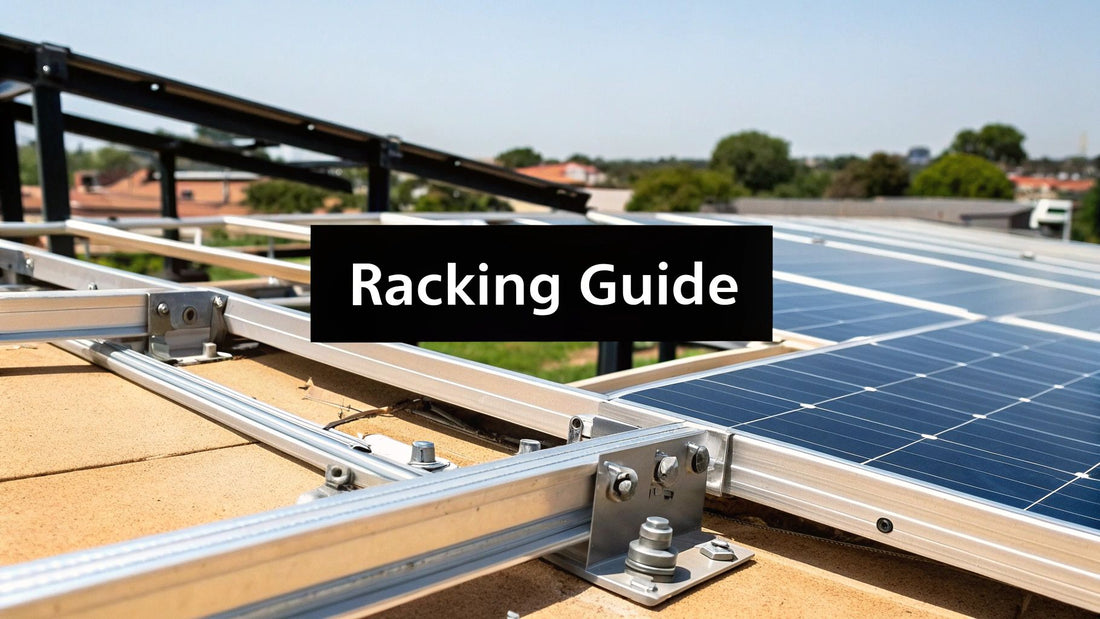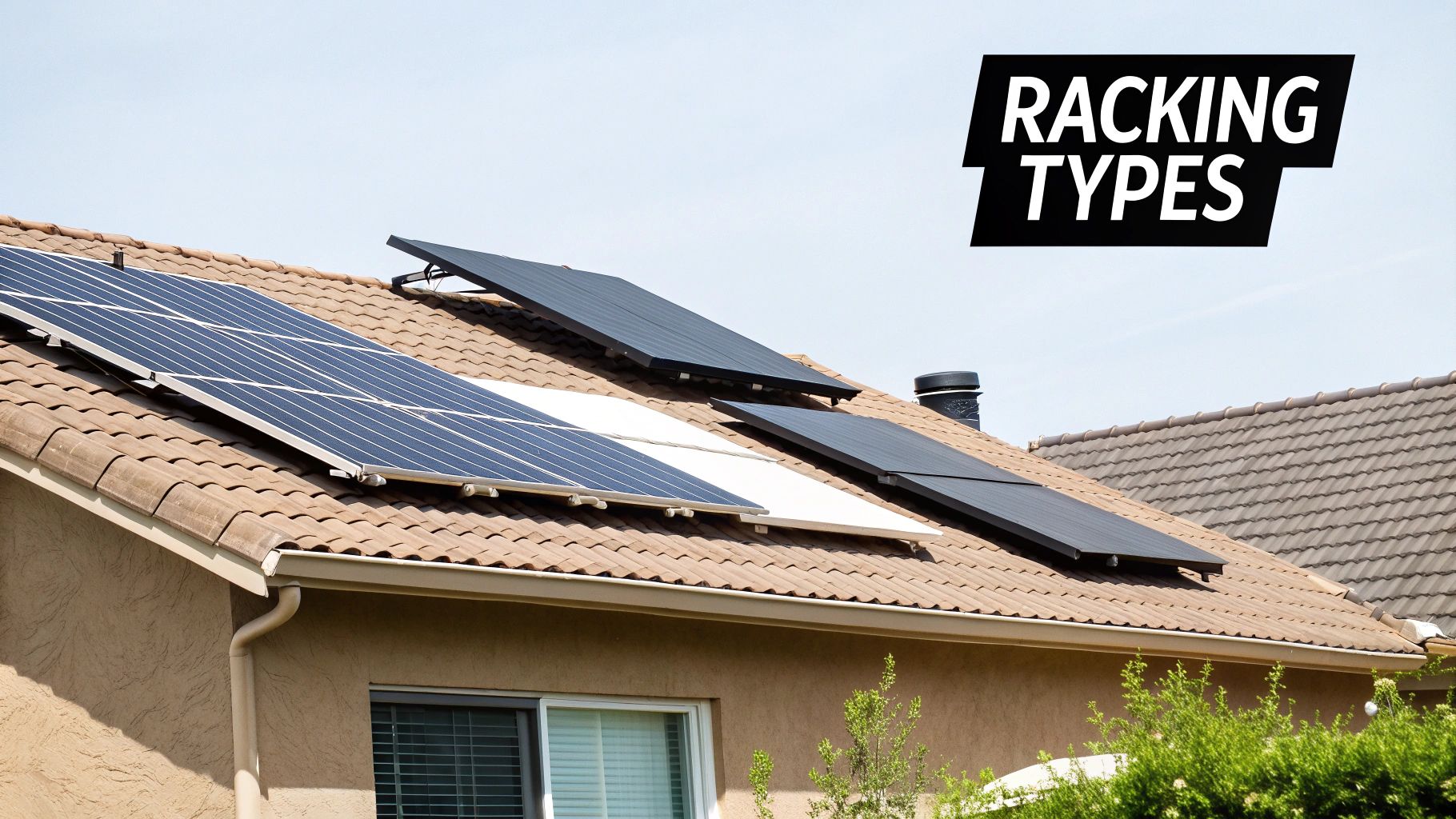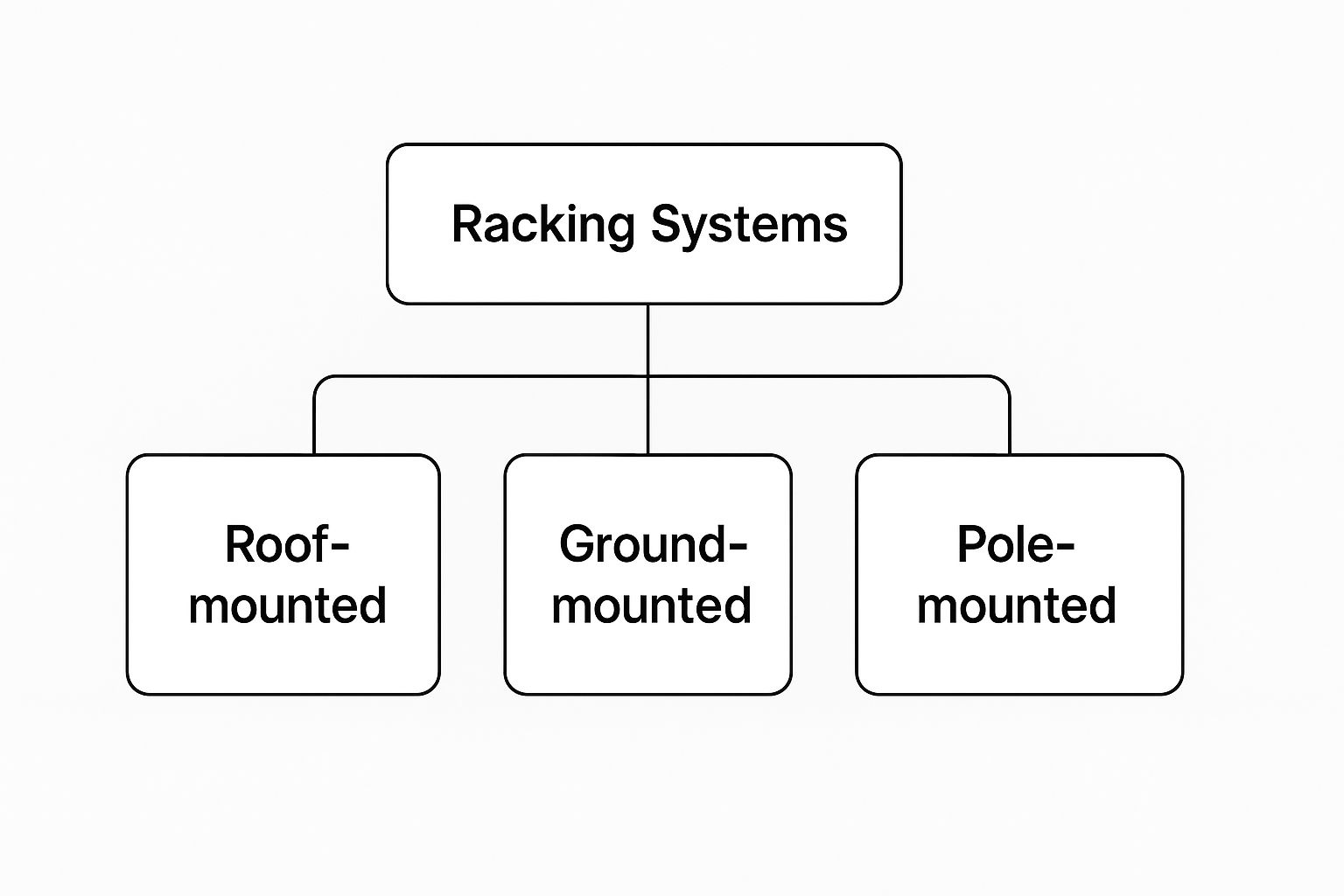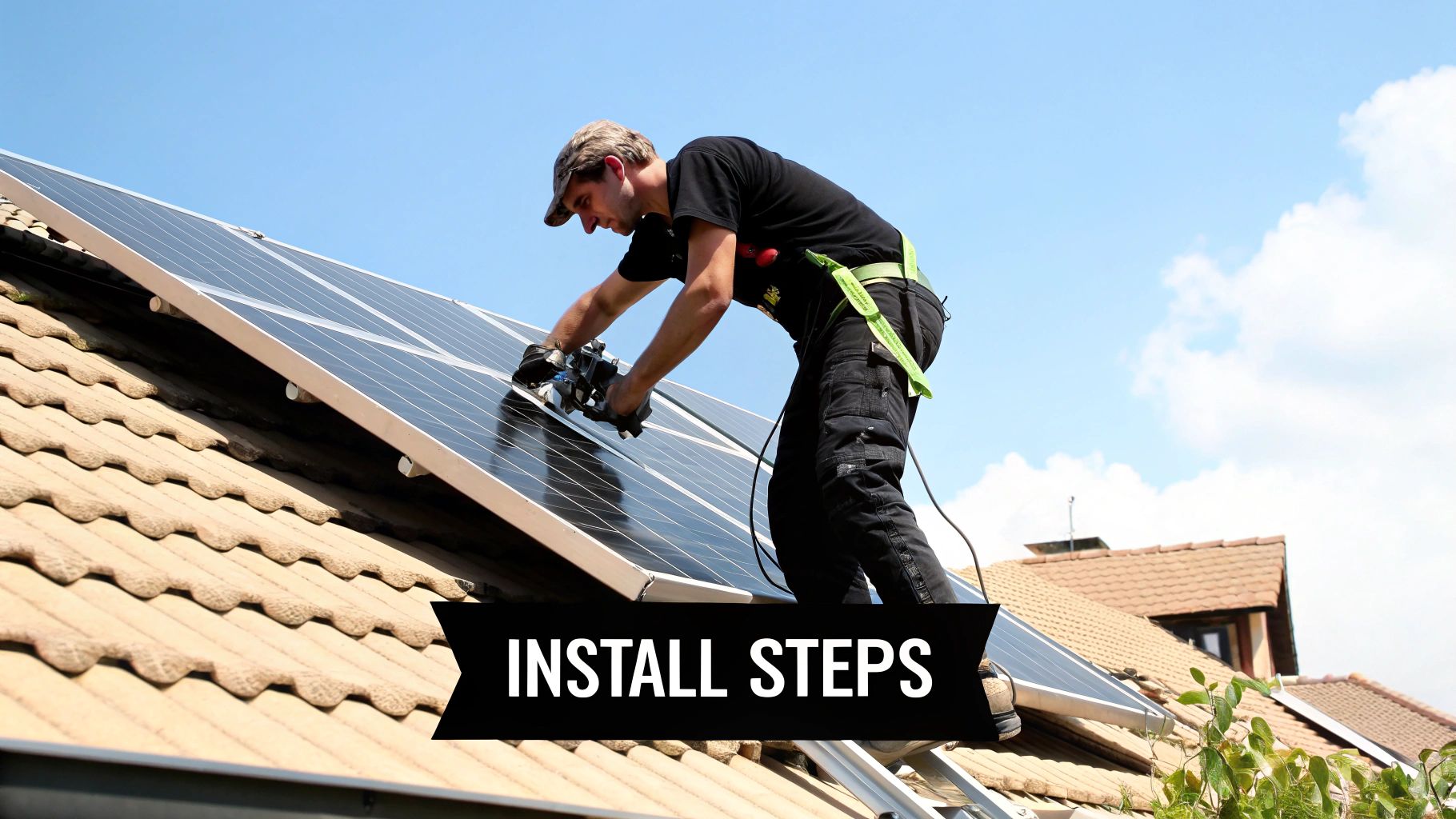
A Guide to Solar Panel Racking Systems
Share
For any solar installer, EPC, or project developer, solar panel racking systems are the engineered backbone of any high-performing solar asset. This single procurement decision impacts structural integrity, long-term bankability, labor costs, and your ability to meet critical U.S. compliance standards like NEC and UL 2703. Get it right, and you build a reliable, profitable system. Get it wrong, and you're facing budget overruns, project delays, or catastrophic failure.
This guide provides a decision-making framework for selecting the right racking, balancing site-specific realities with project goals to ensure a smooth, code-compliant, and profitable installation.
Why Racking Is the Foundation of Project Success
Think of solar racking as much more than just a set of metal rails. It's the engineered layer that physically connects your high-value solar modules to the building or ground, built to withstand decades of relentless environmental stress.
Its performance is directly tied to the safety, efficiency, and ultimate ROI of the whole array. A system with pre-assembled parts can slash labor hours on site, boosting your bottom line. On the flip side, the wrong spec can lead to expensive change orders, crippling project delays, or even catastrophic failure down the road.
Core Functions and Their Impact
Every racking system, whether for a residential rooftop or a utility-scale solar farm, has several non-negotiable jobs to do. These are the fundamentals that ensure a project is safe, successful, and compliant.
- Structural Support and Durability: First and foremost, racking has to securely anchor the panels. It’s the primary defense against dynamic loads like wind, snow, and seismic events, all while meeting local building codes and standards like ASCE 7.
- Optimized Energy Production: Racking sets the tilt and orientation of the panels. Getting this angle right maximizes sunlight exposure, which directly boosts the system's annual energy output and improves the project's financial performance.
- Long-Term Asset Protection: A quality racking system, typically made from corrosion-resistant aluminum or galvanized steel, is built to last. It ensures the array's structural integrity for its entire 25+ year lifespan, protecting the owner's investment.
The critical nature of this component is obvious when you look at the market. Valued at roughly USD 5.2 billion in 2024, the global solar racking market is expected to more than double to about USD 12.8 billion by 2033. This boom is driven by incentives like the Investment Tax Credit (ITC) that are pushing solar adoption into high gear.
Key Functions of Solar Racking Systems
To put it simply, the racking system is doing several critical jobs at once. For project managers and installers, understanding these functions is key to appreciating how a racking choice impacts the entire project lifecycle.
| Function | Impact on Project Success | Key Standard/Metric |
|---|---|---|
| Structural Foundation | Provides the secure mounting base that withstands wind, snow, and seismic forces, ensuring array safety and longevity. | ASCE 7, Local Building Codes |
| Energy Optimization | Sets the ideal panel tilt and azimuth to maximize solar irradiance, directly increasing kilowatt-hour production and ROI. | kWh/kWp (Annual Yield) |
| Asset Protection | Protects expensive solar modules from physical damage and environmental stress over a 25+ year lifespan. | 25-Year Racking Warranty |
| Labor Efficiency | A well-designed system with fewer parts and pre-assembled components can drastically reduce installation time and labor costs. | Man-hours per kW |
| Code Compliance | Ensures the installation meets all local building, electrical (UL 2703), and fire codes, preventing costly delays and rework. | NEC, UL, Local AHJ |
Ultimately, the racking system is the unsung hero that ensures a solar project is not just built, but built to last and perform as promised.
For the Procurement Manager: The racking you choose has a huge effect on the project's total installed cost, and it goes way beyond the material price. Things like ease of assembly, component count, and shipping logistics can make or break your labor budget. We dig deeper into this in our guide to commercial solar installation costs. A system that costs a few cents more per watt but saves hours of labor on the roof is almost always the more profitable move. This is the kind of strategic thinking that keeps bids competitive and projects in the black.
Comparing Major Types of Solar Racking Systems

Choosing the right solar racking system isn't about finding one "best" product. It's about matching the hardware to the specific job site. This decision has a direct impact on how fast your crew can work, your labor costs, and the final cost per watt.
For procurement managers and system designers, it's crucial to look beyond the spec sheets. You need a real-world understanding of how each system performs in the field to make a smart investment and ensure a smooth, code-compliant install.
Roof-Mount Racking Systems
Roof-mounted systems are the bread and butter for most residential and commercial jobs. They come in several flavors, each designed for different roof types and structural needs.
Flush Mounts
This is your go-to for sloped residential roofs. The rails attach directly to the roof’s structure, letting the panels sit low and parallel to the roofline for a clean, unobtrusive look.
- Best For: Pitched roofs, whether they’re asphalt shingle, metal, or tile, especially when curb appeal matters.
- Pro Tip: Speed on the roof is everything. Systems with fewer parts and integrated flashing, like those from top-tier manufacturers like K2 Systems or IronRidge, cut down on install time and reduce the number of roof penetrations.
Ballasted Mounts
What about commercial flat roofs where you can't drill holes due to a warranty or structural limits? Ballasted systems are the answer. They use heavy concrete blocks to hold the array in place without a single penetration.
- Best For: Big, flat commercial roofs—think warehouses and big-box retail stores.
- Compliance Watchout: Wind load is no joke here. You absolutely need an engineer to confirm the roof can handle the combined weight of the system and the ballast needed to meet ASCE 7 wind speed standards. Miscalculation here can lead to catastrophic failure.
Shared-Rail Systems
This is a smart evolution of the flush mount. Instead of two rails per row of panels, a single rail supports the edges of two adjacent rows. It’s a simple change that reduces the total amount of aluminum, which can trim both material and shipping costs.
- Best For: Larger residential jobs or smaller commercial projects where squeezing every bit of cost out of the materials list is a priority.
Ground-Mount Racking Systems
When a roof just won't work—or for massive energy projects—ground-mount systems offer a tough and adaptable alternative.
Standard Ground Mounts
These are the workhorses of utility-scale solar farms. The racks are anchored firmly in the ground using driven piles, concrete piers, or ground screws. You'll also see them on residential properties with plenty of open land.
- Best For: Utility-scale solar farms and homes with a big backyard.
- Project Impact: While the racking itself might cost more, your crew is working on the ground. That often means a faster, safer installation compared to roof work.
Pole Mounts
A pole mount is exactly what it sounds like: a small number of panels mounted on a single, tall pole set in concrete. It’s a great way to get your array up above ground-level trees or other obstructions that would otherwise cast shadows.
-
Best For: Off-grid setups, remote telecom sites, or any small array that needs to be elevated for maximum sun exposure.
For the System Designer: Your racking choice is a fundamental input for system layout and energy modeling. With a ground-mount, you can dial in the perfect tilt angle for the site's latitude, which can boost annual production by 5-15% over a fixed-pitch roof system. To see how innovative hardware solves real-world challenges, you can explore K2 Systems solar mounting technology.
Solar Trackers
When maximizing every last watt is the goal, solar trackers are the premium option. Their higher upfront cost is often justified by a significant increase in energy harvest and a better ROI.
- Single-Axis Trackers: These systems follow the sun on its daily journey from east to west. They're now the standard for new utility-scale projects, boosting energy yield by a massive 15-25%.
- Dual-Axis Trackers: These track the sun not only from east to west but also account for the sun's seasonal high/low path in the sky. They deliver the biggest energy gain (up to 30% or more), but their complexity and cost mean they're usually reserved for very specific, high-value applications.
Choosing the Right Racking Materials for Durability
When you're building a solar project designed to last for decades, the racking system is its literal backbone. The long-term performance and financial viability of the entire system hinge on the materials holding everything together. For engineers and developers, this isn't just a line item on a spec sheet; it's a critical decision that dictates maintenance costs, reliability, and ultimately, the project's ROI over a 25+ year lifespan.
This is where material science meets the real world, ensuring the structure you build today is still standing strong tomorrow.
The chart below lays out the high-level categories of racking systems. Think of it as the first decision point before diving into the specific materials that make them work.

As you can see, whether you're mounting on a roof, the ground, or a pole, the choice of material is the foundation for everything that follows.
Aluminum: The Lightweight Standard
For residential and most commercial rooftops, aluminum is king. And for good reason. Its natural resistance to corrosion means it holds up incredibly well in most environments without any special treatment.
But its real magic is the strength-to-weight ratio. Lighter racking means less dead load on the building's structure, which can save a ton of headaches (and money) on structural engineering. It also makes life easier for the installation crew, as lighter components are easier to handle on a roof and cheaper to ship to the job site.
Galvanized Steel: The Utility-Scale Workhorse
When you move from rooftops to massive ground-mount solar farms, the economics change. This is where galvanized steel takes over. By coating standard steel in a protective layer of zinc, you get a cost-effective powerhouse perfect for large-scale projects.
Sure, it's heavier than aluminum. But its raw strength allows for much longer spans between support posts, meaning fewer foundations to dig and less concrete to pour. On a multi-megawatt project, those savings add up fast.
For Developers: The cost difference between steel and aluminum at the utility scale can be massive. Choosing galvanized steel is often a key strategy for hitting aggressive cost-per-watt targets without sacrificing the structural integrity needed to last a quarter-century in the field.
Stainless Steel: For The Harshest Conditions
What happens when your project is right on the coast or next to an industrial plant? You bring in the tough stuff: stainless steel. By adding chromium to the alloy, stainless steel creates its own passive, self-healing layer that fights off rust and corrosion like nothing else.
You'll see stainless steel specified in places where other metals just won't survive:
- Coastal Installations: It can handle the relentless salt spray that would eat away at other materials.
- Industrial Sites: It stands up to the airborne pollutants and chemicals often found near factories.
- Critical Components: Even on aluminum or steel systems, you’ll often find that the most important nuts, bolts, and clips are made from stainless steel for maximum longevity.
It definitely comes with a higher upfront cost, but in these environments, it’s not a luxury—it's a necessary investment to prevent catastrophic failure and protect the asset for the long haul.
How to Pick the Right Racking System

Choosing the right solar panel racking system isn't about finding the cheapest option on a spreadsheet. It's about a methodical approach that balances the realities of the job site with your long-term performance targets. For seasoned pros, having a repeatable selection process is what separates a smooth, profitable install from a nightmare.
This isn't just a checklist. Think of it as a decision-making tool that forces you to look at the whole picture—from the roof sheathing or soil type all the way to the final bill of materials. It’s how you make sure nothing critical gets missed in the heat of design and procurement.
Start with the Site Itself
The first, and most important, filter is the physical location of the array. The site's unique quirks will immediately disqualify some racking options while pushing others to the top of the list. Every single project has to start with a boots-on-the-ground assessment of these core elements.
- For Roof-Mounts: What kind of roof are you dealing with? Asphalt shingle, standing seam metal, tile, or a flat membrane? Each surface demands specific attachments and flashing to keep water out and maintain the roof's integrity. The roof's age and condition are also deal-breakers.
- For Ground-Mounts: A geotechnical report is your best friend. The soil—whether it's rocky, sandy, or clay—dictates your foundation. You need to know if you're using driven piles, helical piers, or concrete ballasts before you can even think about ordering rails.
A great first step in this process is figuring out your layout. Using a solar panel area calculator helps you see exactly how many panels you can fit and where, which is critical info to have before you start picking out hardware.
Account for Mother Nature
Your racking is the array's front line of defense against the elements. Every design has to be engineered to handle the worst-case environmental forces it will see over its 25+ year lifespan. This isn't optional; it's required by local building codes and ASCE 7 standards.
Pro Tip for Installers: Never, ever guess on load calculations. There's a reason a structural engineer's stamp is required. Getting wind uplift or snow load wrong can lead to total system failure, voided warranties, and a world of liability.
You need to nail these key calculations:
- Wind Load: This is huge for ballasted systems on flat roofs and any ground-mount in an open field. The math has to factor in the building’s height, exposure category, and local wind speed codes.
- Snow Load: In colder climates, the racking has to hold the weight of the heaviest possible snowpack. The entire system must be designed to avoid mechanical stress on the modules and the structure underneath them.
Nail the Hardware and Labor Details
The last part of the process comes down to the hardware itself and how quickly your crew can get it installed. These factors hit your labor budget and project timeline directly.
Module Compatibility is a major checkpoint. You have to verify that your racking is UL 2703 listed for the specific solar panel model you're using. This is what ensures proper bonding, grounding, and mechanical connections—things an inspector will absolutely be looking for.
Installation Speed is where you make or lose money. A system that costs a bit more but comes with pre-assembled parts or fewer components can easily save you hundreds of labor hours on a commercial job.
For Procurement Managers: When you get a quote, ask for the full bill of materials. Don't just look at the price per rail. Compare the number of clamps, bolts, and other little pieces. A lower component count almost always means a faster, more profitable installation.
Racking System Selection Matrix
To simplify the decision, this matrix lines up the most common racking types against key project factors. It's a quick way to see which system naturally aligns with the demands of your specific job.
| Project Factor | Roof-Mount (Flush) | Ground-Mount (Fixed) | Solar Tracker (Single-Axis) |
|---|---|---|---|
| Available Space | Limited to roof area | Requires open land | Requires significant open land |
| Initial Cost | Low to Moderate | Moderate | High |
| Installation Speed | Fast | Moderate | Slow |
| Best for Soil Type | N/A (Roof dependent) | All (with proper foundation) | Stable, non-rocky soils |
| Energy Output | Good | Better | Best (+15-25%) |
| Maintenance | Low (access can be difficult) | Low (easy access) | Moderate (moving parts) |
| Ideal Application | Residential, small commercial | Large residential, commercial, utility | Utility-scale, large commercial |
By working through the site conditions, environmental loads, and hardware logistics in a structured way, you can confidently choose a solar panel racking system that’s perfectly suited for each project's unique challenges. This matrix is a great starting point, but always dig into the specifics with your supplier and engineer.
Installation Best Practices and Common Pitfalls
Let's be honest: a top-of-the-line solar panel racking system is only as good as the hands that install it. For installers in the field and the project managers backing them up, a successful job isn't just about speed. It's about doing it right the first time to mitigate risk, guarantee the system's safety for decades, and sail through inspections without costly red tags and delays.
The real work starts long before anyone steps on the roof. A solid pre-installation check is your first line of defense. This means meticulously checking the bill of materials against the plans, making sure every last nut and bolt is on-site, and doing one final review of the layout and measurements. That simple discipline right there prevents the all-too-common scramble for missing parts or, worse, making expensive guesses mid-install.
Critical Procedures for a Flawless Install
A few key steps, when done with precision, separate a 25-year power-generating asset from a source of expensive callbacks. These are the areas where you never, ever cut corners.
- Proper Roof Penetrations and Flashing: Every hole you drill in a roof is a potential leak, period. Using the right flashing for the job—like the tried-and-true products from IronRidge or K2 Systems—is non-negotiable. Each one has to be installed perfectly, slid neatly under the shingles above it and sealed to code, creating a watertight barrier that will outlast the system itself.
- Adhering to Torque Specifications: That torque wrench in your tool bag isn't just for show. Every single bolt and clamp in a racking system has a specific torque value from the manufacturer. Over-tighten, and you risk stripping bolts or even cracking a module frame. Under-tighten, and you're setting the stage for components to work loose, which can lead to catastrophic failure in the first big windstorm.
- Implementing Robust Wire Management: Dangling wires aren't just ugly; they're a massive safety hazard. Wires left exposed to the sun will degrade, and any cable rubbing against a rough roof surface is an abrasion failure waiting to happen. Use UV-resistant zip ties and proper wire clips to secure everything neatly inside the rails. It protects the conductors, keeps the inspector happy, and makes life easier for the next person who has to service the system.
And since most of this work happens high off the ground, always follow an essential safety guide for working at heights. It’s the most important step of all.
Critical Mistakes to Avoid
Even the most seasoned crews can fall into common traps. Knowing what they are is the first step to making sure your team avoids them.
For the Field Installer: Rushing is the fastest way to get a red tag. Take the extra 60 seconds to double-check your rail spacing. Put your torque wrench on that last mid-clamp again. Make sure your wire management is clean. A few minutes of extra care on the roof saves hours of rework and painful follow-up inspections.
- Improper Rail Spacing: Rails aren't just placed wherever they look good. Their spacing is precisely engineered based on the panel's specific load points and the local wind and snow loads. Going off-plan can void the module warranty and weaken the entire array.
- Ignoring Thermal Expansion: Aluminum rails expand in the heat and shrink in the cold. It's just physics. For long runs of rail, you absolutely must leave expansion joints at the specified intervals. Skip this step, and you'll see rails buckle and warp over time, putting incredible stress on the modules and mounts.
This commitment to quality installation is what’s driving the industry forward. The solar panel mounting market is a huge piece of the renewable energy puzzle, valued at over USD 18.51 billion in 2025 and projected to shoot past USD 53.03 billion by 2035. That explosive growth, as seen in market trends from researchnester.com, means getting these installations right is more important than ever.
- Failing to Verify Grounding and Bonding: According to the UL 2703 standard, the racking itself is often part of the equipment ground. This means you need a solid, unbroken electrical path from every single module all the way to the grounding electrode. Use the right bonding hardware, and then prove it works by checking the continuity with a multimeter. It’s a critical safety check, and you can bet the inspector will be looking for it.
For a deeper dive, check out our comprehensive solar panel installation guide that covers the entire process. By focusing on these best practices, your crew can build safe, compliant, and rock-solid solar arrays every single time.
The Future of Solar Racking Technology

If you're a developer or procurement officer mapping out projects with a 25-year lifespan, you know that looking ahead isn't just an exercise—it’s a core part of the job. Solar panel racking systems are no longer just static, metal skeletons. They're evolving into smart, dynamic platforms that squeeze more efficiency out of an array, bring down costs, and even create entirely new ways to deploy solar. Making a future-proof decision today means getting a clear view of where the hardware is headed.
The global solar boom is pouring fuel on this fire. Just look at the residential market, which shot up by 34% globally in a single year, from 2.9 GW in 2020 to 3.9 GW in 2021. That kind of explosive growth, tracked in reports by firms like Knowledge Sourcing Intelligence, forces manufacturers to innovate—and fast. The pressure is on to deliver racking that’s smarter, quicker to install, and more adaptable than ever before.
Smart Racking and Integrated Technology
The next wave of racking is becoming an active part of the system’s brain. We’re already seeing sensors integrated directly into the mounting hardware, giving asset managers a real-time view of what the array is experiencing.
Imagine getting an alert because a specific section of a solar farm is under unusual stress from a wind gust or heavy snow load. This isn't science fiction. This data allows for proactive maintenance, helping developers prevent catastrophic failures before they ever happen. It’s a game-changer for optimizing large-scale operations.
Advancements in Rail-Less Systems
On the residential and small commercial side, looks and speed are everything. That's why rail-less racking is catching on so quickly. Instead of long, cumbersome aluminum rails, these systems use smaller mounting blocks that attach directly to the roof.
The benefits are pretty clear:
- Reduced Material Cost: Fewer big parts mean lower hardware and shipping bills.
- Faster Installation: Crews are handling fewer, lighter components, which can shave a ton of time off the install.
- Improved Aesthetics: The panels sit closer to the roof, giving it that sleek, built-in look homeowners love.
For Procurement Officers: It’s easy to see rail-less as just a cost-cutting move, but its true value is in labor efficiency. When you're comparing bids, don't forget to calculate the savings from reduced hours on-site. A system that looks more expensive on paper might actually be the more profitable choice.
Agrivoltaics and Dual-Use Land Solutions
One of the most promising frontiers is agrivoltaics, where solar generation and agriculture share the same piece of land. This isn't your standard ground-mount setup. It demands specialized solar panel racking systems designed to be much taller and more spread out.
The goal is to let enough sun hit the ground for crops to thrive, all while leaving enough room for tractors and other farm equipment to pass underneath. As land gets more expensive and harder to find, agrivoltaic racking offers a brilliant way to get two uses out of a single site—producing both clean energy and food. It’s innovations like these, along with market pressures like domestic content requirements under the IRA, that are completely changing how we plan and build solar projects.
Still Have Questions About Solar Racking?
Let's cut through the noise. Here are some straight answers to the most common questions our team gets from installers, developers, and homeowners about solar panel racking.
How Long Does a Solar Racking System Actually Last?
You should expect a top-tier solar panel racking system to last for 25 years or more. Reputable manufacturers back their products—usually made from tough aluminum or galvanized steel—with warranties that match the 25-year performance guarantees you see on the panels themselves.
But remember, the real-world lifespan comes down to the quality of the materials, the local climate (think corrosive salt spray or heavy snow loads), and how well it was installed. Sticking to the manufacturer's specs isn't just a suggestion; it's essential for making sure the system holds up for decades.
Is Getting a Structural Engineer's Stamp Really Necessary?
Yes, almost every single time. The vast majority of local permitting offices will require a licensed structural engineer to sign off on your solar plans before they issue a permit.
This isn't just red tape. It's a critical safety check to confirm that your roof or the ground can handle the dead load of the array plus the dynamic forces from wind and snow it will face over its lifetime. It’s an absolute must for a safe, compliant, and insurable project.
How Much More Power Do You Get with Solar Trackers?
Solar trackers are a game-changer for production. They use motors and sensors to literally follow the sun across the sky, keeping your panels perfectly angled to soak up the maximum amount of direct sunlight all day long.
A single-axis tracker can boost your annual energy harvest by a solid 15-25% compared to a fixed-tilt system. Step up to a dual-axis tracker, and you could see a production increase of over 30%. That’s why the higher upfront cost often pencils out for large-scale projects chasing maximum ROI.
Can I Use Any Racking with Any Solar Panel?
Definitely not. While there's a lot of cross-compatibility out there, you have to verify that the racking you want is certified for the specific panel model you're using.
Things like the panel's frame size, thickness, and its mechanical load ratings all matter. Racking manufacturers publish compatibility sheets for this exact reason. Mismatching components is a fast way to void the warranties on both your panels and racking, and you could run into serious code violations with UL 2703 for system bonding and grounding.
Ready to spec the right racking and BOS for your next project? The experts at Portlandia Electric Supply can provide a full bill of materials, NABCEP-certified design review, and competitive pricing with nationwide delivery. Request a Bulk Quote today and see how our logistics and in-stock inventory can keep your project on schedule and on budget.
